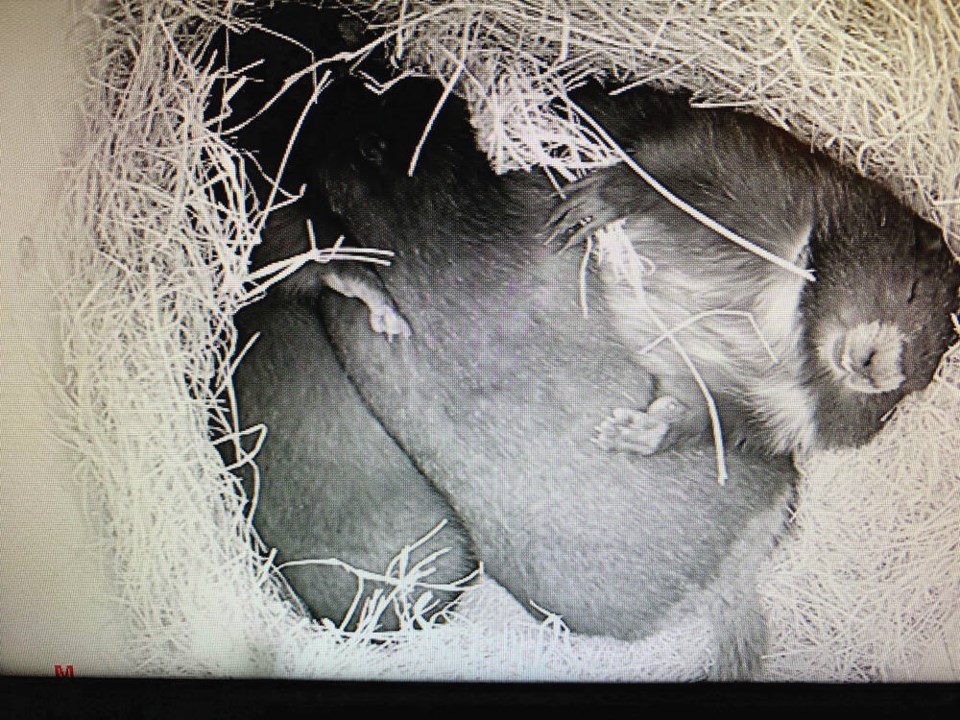Van Isle Violet awoke from deep hibernation and saw her shadow during a health check at the Mount Washington Marmot Recovery Centre on Wednesday.
According to the legend of Groundhog Day, we’re in for six more weeks of winter.
And that’s a good thing for one of the world’s most endangered mammals, says Adam Taylor, executive director of the Vancouver Island Marmot Recovery Foundation.
“If we left it up to the marmots, they would want six more weeks of winter every time,” said Taylor.
He said heavy snow packs are essential to marmot survival for several reasons, including keeping their hibernation burrows at consistent cooler temperatures so they don’t have to burn as much energy, which is essential to their overall health and potential for successful births in the spring.
Heavy snowfalls in the alpine also trigger avalanches, which “scrape the meadows of tree advancement” and create habitat for plants that the marmots need to eat and establish their colonies, Taylor said.
Clear meadows also provide a good buffer against predators, because the marmots can easily see them and send out warning signals.
“Marmots thrive on winter,” Taylor said. “Big snow packs can persist over the course of summer and that melt helps support the plants marmots need.”
German immigrants brought the Groundhog Day tradition to Pennsylvania in 1886, when the editor of a newspaper began promoting Punxsutawney Phil’s weather prowess — if he sees his shadow, there will be six more weeks of winter, and if not, it means an early spring.
Van Isle Violet briefly awoke on Wednesday when her handlers at the recovery centre atop Mount Washington were using electronic devices to measure her weight, temperature and other health indicators. She let out a sharp chirp — maybe seeing her shadow in a lamp — and drifted back to sleep.
Violet was born last June at the Mount Washington Recovery Centre and is part of a captive breeding program also operated out of the Toronto and Calgary zoos.
This year, there are 94 Vancouver Island marmots in captive breeding programs in Canada, including 67 at Mount Washington.
Violet is healthy and ready to be released into established colonies in Strathcona Park in the spring, said Taylor.
The Island’s unique marmot species, considered critically endangered, hit a low point of fewer than 30 animals in 2003. But massive recovery efforts — including breeding programs, a dedicated recovery centre, supplemental feedings for breeding females and habitat protections — have helped to slowly rebuild populations on the Island’s alpine meadows and slopes.
In 2013, the population hit a high of 346, but weather and predators, among other factors, took a huge toll. In 2014, 266 animals were counted, but the population dipped again. In 2020, the count was 200.
Taylor said about 250 marmots were counted in the wild in 2021, mainly in large colony groups around Mount Washington, Strathcona Park and the Nanaimo Lakes regions.
Taylor said 60 pups were born in 2020 and 70 pups emerged in 2021, thanks to increasing numbers of breeding-age females. Vancouver Island marmots typically give birth every two years, and only start breeding at about age three.
However, as with most wild mammals, mortality is high among yearlings, said Taylor.
With every gain in population, there are setbacks for Vancouver Island marmots.
The original Van Isle Violet was one of 30 tagged marmots killed by cougars around Mount Washington last summer. She was eight years old.
Other untagged marmots might have also been taken by the big cats, so the total loss won’t likely be known until the Marmot Recovery Foundation count is complete when the colonies emerge from hibernation, which ranges from April until June.
Taylor said the Mount Washington area is normally safe from predators like cougars because of the amount of human activity in the area. However, researchers say the summer heat dome and prolonged drought may have been a factor. Vegetation such as lupin — a flowering plant favoured by marmots — gave way to taller vegetation like fireweed in some areas, and provided cougars with more cover to stalk the marmots.
Taylor said current conditions for the marmots seem good, with colonies buried under a two-metre snowpack.
Dozens of marmots from captive breeding programs are expected to be released in the spring.
Taylor credits the many researchers, scientists and members of the public who donate to the foundation with saving the struggling population of Vancouver Island marmots. “Without all these people, there’s no doubt this species would have been extinct right now,” he said.
For information on how to get involved or donate, go to marmots.org.



